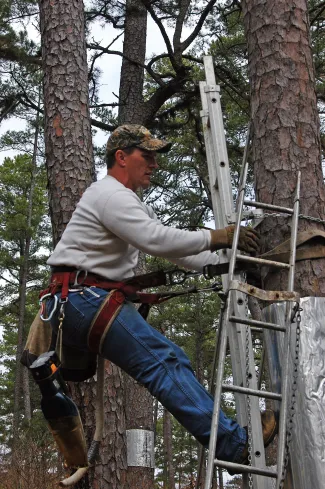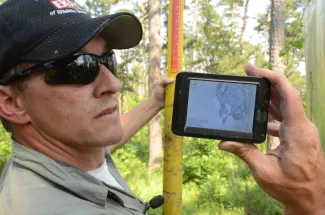The Wildlife Department's oldest management area, the McCurtain County Wilderness Area, was created in 1918 and is home to Oklahoma's only remaining red-cockaded woodpeckers. We followed biologists during this area's centennial year as they tracked these endangered birds and worked to restore the forested habitat on which the birds rely.
For Clay Barnes and Jordan Shope, a wildlife biologist and a technician for the Oklahoma Department of Wildlife Conservation, going to the office means driving an ATV packed with climbing gear and a telescopic camera onto a small pontoon boat, crossing Broken Bow Lake, then navigating the twisting trails within McCurtain County Wilderness Area's 14,000-plus acres.
Together, they manage the Wildlife Department's original conservation area and a small population of red-cockaded woodpeckers found there.
Barnes and Shope are tasked with monitoring the rare birds, especially during their vulnerable nesting season, and maintaining the area's habitat throughout the year so the birds can persist in Oklahoma.

"Wildlife and habitat go hand-in-hand," Barnes said. "And for Oklahoma's red-cockaded woodpeckers, habitat means shortleaf pines with cavities serving as roost and nest trees, and an open understory for foraging."
Like other woodpeckers, red-cockaded woodpeckers live and raise their young in holes they've created in trees. But this particular species only builds cavities in living pines infected with the naturally occurring red heart fungus. The fungus softens the wood, making it easier for the woodpeckers to hollow out a small cavity. Even with the softened wood, construction may take two years.
"Red-cockaded woodpeckers are social and live in small family units in a group or cluster of trees. After a roost cavity is drilled, the birds chip bark away from the entrance hole. This lets the sticky pine resin found underneath the bark coat each bird's tree and offers some protection from potential predators like snakes."
The birds maintain resin flows year-round, which stains active woodpecker trees a dull gray.
Barnes and Shope take note of which trees the woodpeckers appear to be using as they monitor the birds throughout the year. But the significance of gray, or active, trees increases substantially during the spring nesting season.
Spring: A New Generation
"We had 11 breeding pairs of birds on the area last year and expect a similar number this year," Barnes said. "These woodpeckers are unique among Oklahoma's birds in that the breeding pair gets help from last year's offspring in nest duties like incubating eggs and caring for young."
To find out which cavity tree will house the next generation, Barnes and Shope use a bright yellow telescoping pole with a small camera mounted at the top to peek into each cavity.

"Most of our cavities are built about 30 feet above the ground," Barnes said. "Thanks to the peeper cam, we can check a cluster of five to seven trees in five minutes or less. Without it, we would have to climb each individual tree and use a small mirror to see into the cavity."
The latest round of cavity checks began in late April 2018 and continued until early July, when all nesting activity had ended for the year. At least 14 red-cockaded woodpecker breeding pairs attempted nesting this year, producing a total of 39 eggs.
Summer: Banding Area Birds
By early summer, 24 of the 39 red-cockaded woodpecker eggs had hatched, and the management team had only a few weeks to capture the chicks in their hidden nests and attach unique identification bands to their legs.
"Each bird gets a metal band with a unique number so that if it is recaptured later in life it can be tracked back to its origin at the McCurtain County Wilderness Area. But we also add color bands that denote the year the bird was hatched. This lets us visually track the birds as they mature and hopefully establish new territories on the wilderness area."
Extracting the week-old chicks from their nest cavity can be difficult. It also requires perfect timing. Before handling the chicks, biologists coat their hands in cornstarch so that oils from their skin aren't transferred to the mostly naked chicks. This year, 16 nestlings were banded and returned to their nest cavities.
Fall: Habitat Maintenance
Once the chicks were banded, Barnes and Shope turned their attention to habitat and cavity maintenance. Supplemental cavity inserts were placed to help birds overcome the labor-intensive challenge of drilling a cavity. Metal restrictors were added to natural cavities so that the entrance holes wouldn't be expanded by other woodpecker species. And southern flying squirrels and red wasps were evicted from cavities so the endangered woodpecker could continue to persist on the area.
Beyond cavity tree maintenance, the management team also works year-round to maintain the open forest conditions the birds require. Luckily, the wilderness area's largest neighbor is the U.S. Forest Service, and both agencies share management goals, and in some cases, resources.
"Partnering with the U.S. Forest Service allows us to provide three and a half times more habitat for the red-cockaded woodpecker, and really for a broader wildlife community," Barnes said. "You can really see a difference where we've focused management efforts. It really gives the area life."
The Wildlife Department's television production crew showcased the work of Barnes and Shope in this Outdoor Oklahoma episode.
